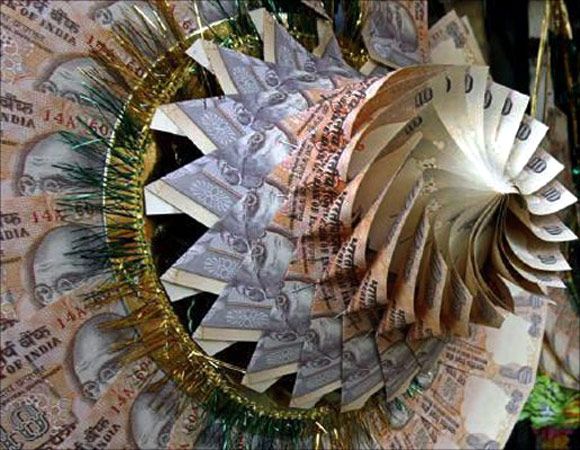 | « Back to article | Print this article |
The best possible move would be for the government to spend the funds on activities like infrastructure development or as it deems fit, says Soumya Kanti Ghosh.

Around Rs 2,482-Rs 4,800 billion of money will not be converted and remain outside the banking system. To that extent, currency liability of the Reserve Bank of India (RBI) will get extinguished.
While there is almost a complete unanimity of the accounting treatment in the sense that corresponding assets will also have to be adjusted, the problem is thereafter. There seems to be complete divergent views in so far as the end-use is concerned.
Just to set the context, there has to be a matching asset movement to match the decline in currency liability as a result of demonetisation. Now, the confusion is how this will be treated in RBI accounting entry.
There are primarily two options on the table.
First, cash pay-out to the government against the assets created on RBI balance sheet (through the sale of US security holdings, OMO etc).
Second, creation of an unclaimed reserve fund in the liabilities (more notional in nature) to match the assets and liabilities in the balance sheet.
We reiterate that the best possible move should be the first one and the government must spend the funds on activities like infrastructure development or as it deems fit.
There is nothing wrong in it, as is being claimed in several circles. In fact, there is precedent for this type of spending and the government and the regulators can take solace from that.
First, there are lessons to be learnt at the international level for extinguishing currency liability. These are from the Deutsche Bundesbank and Bank of Israel. In both the cases (though in the case of Germany, it took a longer time), such was written off from the balance sheet item ‘banknotes and coins in circulation’ and profit recorded in P&L.
Let me now turn to India and start with the debt position of government of India. In 2004, the government of India had launched a market stabilisation scheme in consultation with RBI to absorb excess liquidity arising largely from significant foreign exchange inflows through issue of dated securities/treasury bills.
Interestingly, the receipts from borrowings under MSS is sequestered in a separate account with RBI, with the exclusive proviso that such receipts will not be used for any government expenditure, but for repayments.
Let me now go back further to 1947. If we refer annexure 5 (i) of the Receipts Budget of the government of India, there is a statement of liabilities of the central government of Rs 300 crore as “amount due from neighbouring country on account of share of pre-partition debt” and this is in our book since 1950-51.
Though this is a measly amount compared to the Union government’s total liabilities of Rs 74 lakh crore today, in 1950-51, this amount had accounted for 10.5 per cent of India’s total liabilities of Rs 29 billion and was nearly 10 times that of India's total external debt of Rs 32 crore. If we calculate the present value of the Rs 300 crore by assuming interest rate of seven per cent per annum, it would be a staggering Rs 24,381 crore.
Now, move to RBI’s balance sheet. Banks have around Rs 5,000 crore in unclaimed deposits lying with it as of March 2014. Also, unconfirmed reports suggest that there is an unclaimed total wealth of Rs 64,000 crore in the financial sector, including insurance companies, Employees’ Provident Fund Organisation etc.
However, RBI has established the Depositor Education and Awareness Fund (the Fund) in 2014 and instructed the banks to credit the funds of the deposits that remained unclaimed for 10 years or more. This fund shall be utilised for promotion of depositors’ interest and for such other purposes that may be necessary for the promotion of depositors’ interests, as specified by RBI from time to time.
As of June 2016, the fund value is Rs 10,585 crore and resides in the liability side of the RBI’s balance sheet.
Next, take the example of the 1997 Union Budget. The process of fiscal correction had received a serious setback during FY’98 when fiscal deficit as a proportion of GDP increased to 5.7 per cent from 4.7 per cent in FY'97. Apart from the decline in revenue collections from excise because of low industrial growth, shortfall in disinvestment receipts, the other reason that was quoted was the surge in small savings collections.
It may be noted that at that point of time, small savings collections of states and Union territory were a part of centre’s fiscal deficit, as loans were extended to state government in lieu of such small saving collections. Because of this definitional change, there was a clear decline of 30 basis points in fiscal deficit in that year.
So, what do we learn from the above examples?
First, we can always create a separate entry, say, unclaimed currency liability with the exclusive proviso that the proceeds from such fund must be exclusively used for purposes defined by government and nothing else.
Second, we have precedent for such arrangements as in past and any separate law (if so required) could be purely based on mutual understanding.
Third, if it is still not possible, we then need to ask ourselves, do we carry forward the unclaimed currency liabilities as a source of perpetual drag as, say, we are doing in the government debt book?
I am sure that the fiscal protagonists will not protest such a move if it is for the good for the country.
(Tapas Parida contributed to the research)
The author is group chief economic advisor, State Bank of India.